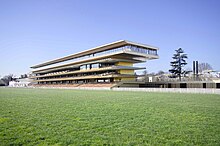
The Prix de l'Arc de Triomphe is a Group 1 flat horse race in France open to thoroughbreds aged three years or older. It is run at Longchamp Racecourse in Paris, France, over a distance of 2,400 metres and scheduled to take place each year, usually on the first Sunday in October.
Corrida was a French Thoroughbred racehorse who won races in France, Belgium, Germany and England and is regarded as one of the top fillies of the 20th century worldwide. She is best known for her back-to-back wins in France's most prestigious horse race, the Prix de l'Arc de Triomphe.

The Bois de Boulogne is a large public park that is the western half of the 16th arrondissement of Paris, near the suburb of Boulogne-Billancourt and Neuilly-sur-Seine. The land was ceded to the city of Paris by the Emperor Napoleon III to be turned into a public park in 1852.
A hippodrome was an ancient Grecian horse and chariot racing course and arena. Hippodrome or Hipódromo may also refer to:

Hippodrome Deauville-La Touques is a race track for thoroughbred horse racing located in Deauville in the Calvados département, in the Normandy région of France. Originally called Hippodrome de la Touques, it was named for the Touques River that separates the city of Deauville from Trouville-sur-Mer. It was constructed in 1862 by Charles Auguste Louis Joseph, duc de Morny, the half brother of Napoleon III.
The Jockey Club de Paris is a traditional gentlemen's club and is regarded as the most prestigious of private clubs in Paris. It is best remembered as a gathering place of the elite of nineteenth-century French society. Today it is decidedly but not exclusively aristocratic. The club seat is at 2, rue Rabelais in Paris, near the Champs-Elysées and it hosts the International Federation of Racing Authorities.

The Hippodrome de Maisons-Laffitte at 1 avenue de la Pelouse in the northwestern Parisian suburb of Maisons-Laffitte in France was a turf horse racing facility and track for Thoroughbred flat racing. Opened in 1878 by Joseph Oller, inventor of the pari-mutuel machine, it sits on 92 hectares that belonged to the wealthy banker Jacques Laffitte.
Golden Pheasant is an American Thoroughbred racehorse who won races in France, England, the United States, and Japan. He was owned by the then owner of the Los Angeles Kings NHL ice hockey team, Bruce McNall, and superstar Hall of Fame player, Wayne Gretzky.

Chantilly Racecourse is a Thoroughbred turf racecourse for flat racing in Chantilly, Oise, France, about 50 kilometres (31 mi) north of the centre of the city of Paris.

Pearl Cap was a French champion Thoroughbred racehorse who is considered one of her country's greatest racing fillies.
The Prix de Fontainebleau is a Group 3 flat horse race in France open to three-year-old thoroughbred colts and geldings. It is run over a distance of 1,600 metres at Longchamp in April.
The Breeders' Cup Turf Sprint is a Weight for Age stakes race for thoroughbred racehorses three years old and up. As its name implies, it is a part of the Breeders' Cup World Championships, the de facto year-end championship for North American thoroughbred racing. The distance of the race will vary depending on the host track's turf course requirements.
Royal Heroine (1980–2002) was a Hall of Fame Thoroughbred Champion racehorse foaled in Ireland who raced in England and France and then in the United States where she set a North American record for a mile on turf while winning the inaugural running of the Breeders' Cup Mile in 1984. Royal Heroine was inducted into the US National Museum of Racing and Hall of Fame in 2022.
Finasseur (1902–1909) was a French Thoroughbred racehorse who, at age three, won the two most prestigious races in France.
In The Wings (1986–2004) was a Thoroughbred racehorse who raced from a base in France. He was bred and raced by Sheikh Mohammed, and trained in France by André Fabre,

The Races at Longchamp is an 1866 painting by the French artist Édouard Manet. The Impressionist painting depicts the ending of the Second Grand Prix de Paris at Longchamp. It is currently in the collection of the Art Institute of Chicago. This painting is one of four depictions of the same subject that Manet created over four years. The painting reflects the rise of horse racing in France, following the influence of the British. The work is thought to be the first painting to present horses coming directly toward the viewer, and it uses various techniques to reduce the sense of depth.

The Hippodrome de Vincennes, also called Vincennes Raceourse, is a horse racing track located in Paris, France. It has a capacity of 40,000. It was created in 1863 and rebuilt in 1879, after being destroyed in the Franco-Prussian War.
Caracalla was a French racehorse and sire. Unraced as a two-year-old and never competing at a distance shorter than 2,400 metres he was undefeated in eight races in a racing career which lasted from the spring of 1945 until October 1946. Caracalla excelled over extended distances, winning the Grand Prix de Paris and the Prix Royal Oak in France and the Ascot Gold Cup in Britain. On his final appearance he proved himself capable of beating top class opposition at middle distances when he won the Prix de l'Arc de Triomphe. He was then retired to stud, where his record was disappointing.

Solidays is a French annual music festival that takes place at the Longchamp Racecourse in Paris at the end of June. Organized by Solidarité sida, the event brings together more than 150 artists and 170 000 festival-goers for three days. The proceeds from the festival are donated to organisations fighting against HIV/AIDS, especially for those focusing on the African continent.











